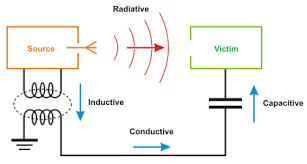Decoupling, Bypassing and Filtering
Decoupling, Bypassing and Filtering
(1) EMI filters can be used as a shunt element to divert
electrical currents from a trace or conductor; as a series element to block a
trace or conductor current; or they may be used as a combination of these
functions. Selection of the filter
elements should always be based on the desired frequency range and component
characteristics. A low pass filter can be
useful for reducing most high frequency EMI problems. It incorporates a capacitive shunt and series
resistance or inductance. However, at frequency
extremes, the capacitor can become inductive and the inductor can become
capacitive causing the filter to act more like a band-stop filter. The filter design type should be based on the
overall impedance at the circuit’s point of application for proper match. A T-filter design is effective for most EMI
applications and is ideal for analog and digital I/O ports.
(2) Capacitors may be used for signal filtering and power source
decoupling within their high frequency performance characteristics. However, their internal and external inductance
can limit performance at high frequencies. Ceramic capacitors are recommended for the high frequencies,
particularly those in the GHz range. A capacitor providing a reactance of less than 1 Ohm at the
frequency of concern should suffice. Capacitor lead and trace lengths must be short at the high
frequencies in order to prevent the addition of inductive reactance.
(3) PC board bypass capacitors used at high frequencies (greater
than 100 MHz) should utilize surface mount technology (SMT) with vias close enough
to the mounting pad to minimize or eliminate the traces. The via holes should be large (greater than .035
inch in diameter) and the PC board should be thin enough to bring power and
ground planes near the body of the capacitor (less than .030 inch thick). Proper design layout of the bypass capacitors
can greatly reduce the power and ground circuit noise by lowering the overall
effective inductance of the capacitors.
(4) Wire wound ferrite inductors may be used for EMI emissions and
immunity filtering at lower RF frequencies. These can supply from about 1 microhenry to 1 millihenry of
inductance. However, they can become
a capacitor above their resonant frequency and are useless in the most common
EMI frequency range of 50 MHz to 500 MHz. Ferrites and ferrite beads are recommended for higher frequency
applications where they become lossy and act more like a resistor. Select a ferrite impedance of about 100 to 600
Ohms at the frequencies of concern.
(5) Shielded I/O cable connectors equipped with bypass capacitors
or filter pins should be used whenever possible.
(6) I/O filters should be inside of the I/O connector (as with
filter pins) instead of on the PC board.
(7) I/O bypass capacitors should be mounted at the I/O connector
instead of on the PC board.
(8) I/O ferrites should be mounted inside of the I/O connector
instead of on the PC board.
(9) A snap-on ferrite bead at the I/O cable connector can provide
3 to 5 dB of common mode absorption.
(10) Multiple ferrites may be used to reduce radiation by up to 10
dB depending on their characteristics at the frequency of interest.
(11) Ferrite beads are available in high-Q resonant and low-Q
non-resonant (absorptive) types. The low-Q beads are recommended for digital circuits and filtering
applications.
(12) External cable or I/O connector filters can provide for a
common mode rejection of greater than 10 dB.
Thanks,
Ruby


Comments
Post a Comment